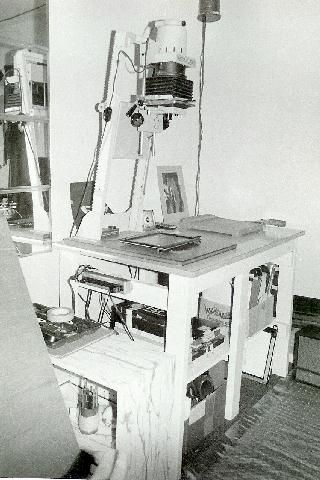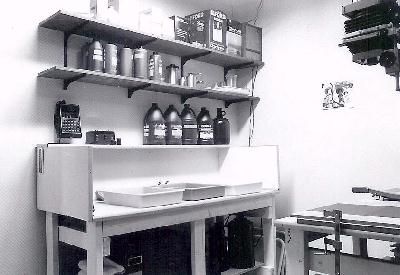Through the Years
- The Brownie
- The 126
- The 110
- Army Years - Part 1
- Army Years - Part 2
- Army Years - Part 3
- Army Years - Part 4
- Army Years - Part 5
- Army Years - Part 6
- Working in a Photofinishing Lab
- Industrial Era - Part 1
- Industrial Era - Part 2
- The 2nd Career
- Into the Fine Arts - Part 1
- Into the Fine Arts - Part 2
Photography Hardware
Processes and Projects
- Main workshop page
- Camera Building
- Pinhole camera
- Camera obscura
- Cyanotype project
- Sabattier effect
- Posterization
- Time Shifting
Photography Galleries
Photography Class Galleries
Photography
The Early Years
Although I was from a family of snap-shooters, I only had a passing interest in photography when I was growing up. I remember that I asked for camera when I was about 10 when we were living in Honolulu and my parents gave me what I think was a Brownie from that era, the early 1960s. I used it to take all sorts of snapshots. You can click on the The Brownie link in the menu on the left to see some pictures and find out more.
Developing one's own film was not unheard of back in those days. I have a pretty vague recollection of going over to the house of someone my dad worked with at Pearl Harbor who had a darkroom in a closet off the living room. Then, in the later 1960s, I had a high school friend who had a darkroom at home and, although I never went over there to see it, he did bring in samples of his work and told me about the process. I found it intriguing but lacked the resources, and maybe the interest, to get into it myself.
Around 1972 I got another snapshot camera, a Kodak 110. I took this camera with me when I went away in the army later in that same year. You can click on the The 110 link in the menu on the left to see some pictures and find out more.
Getting Really Hooked
My interest in photography continued at the minimal level until I found myself in upstate New York, stationed at Camp Drum. I accompanied a friend to watch him develop some film in the base photo lab. While interesting to see, it was the printing process that got me hooked. You can read more about that and my early excursions into photography during my army years by clicking any of the Army Years links in the menu on the left.
Back to Civilian Life
I was discharged from the Army in October 1975 from Fort Dix. I found myself a civilian again, free, with cash from by acrued leave days in pocket, and no idea where to go next. I caught a ride to Philadelphia airport and bought a ticket to Minneapolis/St. Paul where my sister lived. I spent a couple weeks there, water skiing, and taking photos. But life eventually called for me to get it together so I flew back to Southern California. During the next few months I found a one bedroom apartment to rent on Stanley Ave. in Long Beach, acquired an enlarger, developing equipment, and the rest of the supplies and accessories to set up a darkroom in my bathroom.
I found a job in a nearby photofinishing lab where I was a film cutter on an 8-hour midnight shift. Over time I moved up and learned to run a color printer and cross-trained running the color print processor, learned color retouching and spotting, and finally was trained and assumed the new position as quality control technician. I mixed all the chemistry (200 gallons at a time), set up all the machines (speed equalization), ensuring that they worked within specs and produced very few rejects. It was factory work, but it was fun. You can click on the Working in a Photofinishing Lab link in the menu on the left to see some pictures and find out more.
A word about photographic supplies: Freestyle in Hollywood. What else is there to say? While I would look though the ads in Popular Photography magazine, Freestyle was only a 25 minute drive from where I lived and I made that trek every other month or so. I bought chemicals, paper, film, and the occassional piece of hardware. The trip there always included lunch at a great burrito place on Sunset and Western.
 In 1978 I moved from a one bedroom apartment to a two-bedroom duplex. The extra bedroom naturally became a dedicated darkroom. I continued spending long hours in the dark trying out various process which included photo-seriagraphy, posterization, work with half-tone films, more positive color printing, and anything else that struck my imagination.
In 1978 I moved from a one bedroom apartment to a two-bedroom duplex. The extra bedroom naturally became a dedicated darkroom. I continued spending long hours in the dark trying out various process which included photo-seriagraphy, posterization, work with half-tone films, more positive color printing, and anything else that struck my imagination.
In 1979 I left the photo lab and took the summer off, riding my motorcycle on a 7,000-mile adventure around the country and even into Canada. Upon return I took a job with an engineering company and my path down a planned career was taking shape. You can click on the Industrial Era link in the menu on the left to see some pictures and find out more.
 In the early 1980s I bought my first house and the darkroom was, again, set up in the 2nd bedroom and I continued to spend many hours there.
In the early 1980s I bought my first house and the darkroom was, again, set up in the 2nd bedroom and I continued to spend many hours there.
Life altered when children arrived and my darkroom moved to my garage. This was short-lived since I was also doing lots of woodworking and dust from that just doesn't mix well with photography. I had continued my college education and was working on a degree in Industrial Arts at California State University Long Beach with a concentration in photography. I graduated in 1986.
The early 1990s arrived and ushered in a change of career to high school teacher and a move to another state. Photography was very low on my priority list as I scrambled to learn the craft of teaching and the busy family life with two small children. I eventually set up a darkroom in a windowless basement room and put it to some use. Over time I added hot and cold water, a sink, a connection to a drain line, shelving, some lighting, and it actually looked like a functional darkroom. However, I had been away from it for too and was unable to rekindle the same flame of passion to the level it once was. Other flames had ignited in its place and I think of it as not "out" but just in pilot light mode. In the meantime, the world of photography became digital, the Internet came along, and analog materials seemed to be harder to acquire. You can click on the The 2nd Career link in the menu on the left to see some pictures and find out more.
Reigniting the Passion
In about 2015, I started venturing back into the dark. That room had become a place where stuff was put when you weren't quite ready to get rid of it so clutter had to be cleared. I pretty much emptied it out and only put back that which was photographic. I went through all the equipment and cleaned it and made sure it was working properly. I ordered new chemicals, film, and paper. I thought I could pick up where I'd left off but I'd lost the muscle-memory of my workflow. Not only that, the negatives were coming out thin and the prints were dull.
I backed off went back to the books. I reread Ansel Adams series, "The Camera," "The Negative," and "The Print." I shot test film and tried different developers, times, and temperatures. I finally reestablished the workflow and the control I used to have. The passion was slowly being reignited.
It was also around this time I decided to pursue a Bachelor of Fine Art degree at Montana State University-Billings. I was initially motivated by my desire to learn how to draw or at least to expand by drawing skills but as I took the prerequisites I got hooked and decided to pursue the degree. In the Fall of 2017 I took the Photography 1 course which was all analog and thoroughly enjoyed it. With my technical skills reestablished, I was able to concentrate and on bringing a new way to approach the content of my work. I took Photography II, which was all digital, and while I enjoyed the course, it simply lacked that something that the traditional medium has had for me. As of this writing I have only begun to scratch the surface of where I think I can go with this. I am taking an Advanced Photography course next which will look at alternative processes while searching for a link between drawing and photography. The adventure is on. You can click on the Into the Fine Arts link in the menu on the left to see some pictures and find out more.
Created December 2017, updated January 2021.